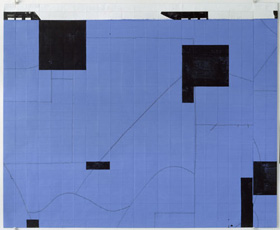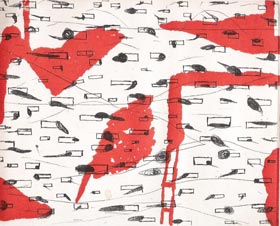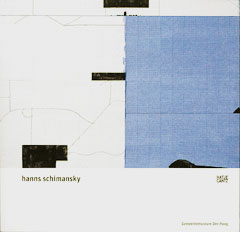| |
| |
|
|

Hanns Schimansky, No Title, 2007, Folding, Indian ink, graphite and gouache on paper 58,8 x 71,5., Private Collection
|
|

German artist Hanns Schimansky (b. 1949) produces highly aesthetic, abstract drawings which are widely appreciated both in his native land and abroad. Using pencil, Indian ink or chalk, he works on sheets of paper of hugely varying size, dashing off lines and organic forms free-hand, in a well-nigh impossible attempt to capture the intensity of the moment. Pushing the limits of the paper, his lines creep right up to the edges or folds and out into the corners. Each drawing represents a controlled interplay between the “now” and the energy released by the pressure of the hand on the paper. The Gemeentemuseum Den Haag is about to host Schimansky’s first ever one-man exhibition in any Dutch museum, comprising recent work from his Faltungen series, from 19 January through 12 May 2008.
Born in East Germany, Hanns Schimansky trained to work in agriculture and is a self-taught artist. It was while working as an agricultural engineer in a farming cooperative that he began drawing landscapes and portraits. These figurative beginnings laid the foundation for his entire oeuvre. His decision to work in pencil and Indian ink was motivated both by the shortage of painting materials in rural East Germany and by his lack of personal affinity with paint and canvas. In his desire to capture the passing moment, he is impatient of the relatively complex and time-consuming nature of painting.
Over the years he has developed a variety of creative procedures, one of the most remarkable being the method he uses to produce his Faltungen. He starts by covering both sides of a large sheet of paper with a smooth coat of paint. He then folds up the paper to form a small package. The next step is to unfold it again and make drawings, on both the front and the back, in the areas outlined by the folds. The demarcated areas serve as guidelines for the drawing process, dictating a particular rhythm. Finally, he folds up the paper in such a way as to create unexpected and exciting confrontations between the drawn areas.
Until around 2000, Schimansky’s work was entirely monochrome. Since then he has introduced mainly bright colours, which form a strong contrast with the sober black and grey that had prevailed in his work up to that point. The presence of warm red or cool blue areas changes the mood of the works and amplifies the graphic energy of the drawings.
Within his self-imposed technical limitations, Schimansky has discovered an aesthetic formal language which is highly accessible to the general public, even though it represents nothing concrete. Its wide appeal is proven by the many exhibitions and multitude of articles devoted to his work. Each exhibition creates a new interplay between the work and the surrounding architecture and light. In the projects gallery at the Gemeentemuseum, Berlage’s architecture binds the drawings together and gives them an extraordinarily powerful collective impact, despite the strongly graphic character they possess as individual pieces.
[Press text Gemeentemuseum The Hague, 2008] |
| |
|
|
|
| |
|
|
|
| |
|
|
Hanns Schimansky, (1949, Bitterfeld) lives and works in Berlin. He is a member of the Academy of Arts, Berlin and since 1998 an appointed professor at the Art College Berlin-Weissensee.
Hanns Schimansky is represented by Galerie Inga Kondeyne (Berlin) and Galerie Jaeger Bucher (Paris) a.o. |
| |
|
|
|
| |
|
|
|
| |
|
|
 |
| |
|
|
|
 Hanns Schimansky, etching (proof), 2009
Hanns Schimansky, etching (proof), 2009 |
|
In 2009-2010 Ergo Pers published a double volume artists' book with John Ashbery, Franck André Jamme and etchings by Hanns Schimansky.
The edition consists of two books:
John Ashbery, The Recital, translated by Franck André Jamme and La Recitation de l’oubli | Les gués, les passes, by Franck André Jamme and translated by John Ashbery.
For both books Hanns Schimansky created a series of five etchings.
|
John Ashbery has achieved a unique status among American poets. Even though much of his work is difficult to read, avant-garde, and post-modernist in character, Ashbery has become revered and beloved by many readers. Three Poems consists of three lengthy and highly intense prose poems called The New Spirit, Theme and The Recital. The three long prose poems ravel and unravel philosophical questions about language's ability to represent the world and about how best to apprehend reality – but these dense matters are leavened with Ashbery's characteristic wit. The third and shortest of the Three Poems, The Recital,' written in April 1971, is now translated into French by Franck André Jamme, and published in a bilingual limited edition by Ergo Pers.
|
John Ashbery, The Recital, translated by Franck André Jamme is published in an edition of 40 copies in December 2009. For this limited edition, Hanns Schimansky created a series of five etchings. |
|
|
|
|
|
|
| |
|
|
|
|
|
|
|
|
|
| |
|
|
|
|
Colophon
The Recital /Le Récital, a prose poem by John Ashbery, bilingual edition in a French translation by Franck André Jamme, in close collaboration with the author and MarieFrance Azar, published in October, 2009, by Ergo Pers, Ghent. Each copy includes five original etchings by Hanns Schimansky and is further accompanied by a suite of five loose prints of the same etchings, signed and numbered by the artist. All forty copies are signed on the colophon page by the author, the artist and the translator.
The Recital /Le Récital is printed in a limited edition of forty copies, numbered in Arabic numerals, with an additional series of twelve reserved copies for the author, the artist and the translator, numbered I-XII. A separate edition of six copies, reserved for participating collaborators and numbered A-F, consists of six original etchings, instead of five. The etchings were printed in Berlin by Fritze Margull. The text is set in Garamond and printed on 230-gramme Hahnemühle paper. Typography, design and printing are by Rein Ergo.
Price: € 1.200.
|
| |
Franck André Jamme, La Récitation de L'oubli, translated by John Ashbery, is published in an edition of 40 copies in December 2009. For this limited edition, Hanns Schimansky created a series of five etchings. |
|
|
|
|
|
|
|
| |
|
|
|
|
|
|
 |
|
|
| |
|
|
|
|
Colophon
La Récitation de l’oubli / Les gués, les passes / The Recitation of Forgetting / Fords, channels, poems by Franck André Jamme, bilingual edition in an English translation by John Ashbery, published in October, 2009, by Ergo Press, Ghent. Each copy includes five original etchings by Hanns Schimansky, is signed on the colophon page by the author, the artist and the translator, and is further accompanied by a suite of five loose prints of the same etchings, signed and numbered by the artist.
Les gués, les passes / Fords, channels, is printed in a limited edition of forty copies, numbered in Arabic numerals, with an additional series of twelve reserved copies for the author, the artist and the translator, numbered I-XII. A separate edition of six copies, reserved for participating collaborators and numbered A-F, consists of six original etchings, instead of five. The etchings were printed in Berlin by Fritze Margull. The text is set in Garamond and printed on 230-gramme Hahnemühle paper.Typography, design and printing are by Rein Ergo.
Price: € 1.200.
|
|
| |
|
|
John Ashbery was born in Rochester, New York, on July 28, 1927.. He has won nearly every major American award for poetry and is recognized as one of America's most important, though still controversial, poets. After the publication of Three Poems (1973), written in long blocks of prose, Ashbery in 1975 won all three major American poetry prizes (the Pulitzer Prize, the National Book Award, and the National Book Critics Circle Award) for his Self-Portrait in a Convex Mirror.
John Ashbery is the author of more than twenty books of poetry, most recently Planisphere (Ecco, 2009), A Worldly Country (2007) andWhere Shall I Wander (2005). Three poems was published in 1977 by Penguin Books (New York).
It’s “an abstract and evocative poetry,” to quote John Olson (writing in Talisman magazine) . It’s also poetry, to borrow again from Olson, that’s often difficult to say what it is about. As Olson writes, it “approaches and recedes from meaning.”
|
| |
|
|
|
| |
|
|

|
 Hanns Schimansky, cat. Gemeentemuseum The Hague, 2008
Hanns Schimansky, cat. Gemeentemuseum The Hague, 2008 |
|
Hanns Schimansky, cat. Gemeentemuseum The Hague, 2008, German/English, 24 x 23,5 cm, pp.
99.
Hanns Schimansky, Quellenfeld, Stattliche Kunsthalle Karlsruhe, 2003 [ texts by Klaus Schrenk, Kirsten Claudia Voigt, Robert Kudielka ].
Hanns Schimansky, Soixante - quatorze dessins, Editions Musée d'art et d'histoire, Neuchâtel, Schweiz, 2000 [
texts by Eugen Blume, Rainer Borgemeister, Inga Kondeyne, Christian Schneegass, John
Sundkvist, Walter Tschopp ]. Read more. |
| |
|
|
|
| |
|
|

|
| |
|
|
 |
| |
|
|
|
| |
|
|
|
| |
|
|
|
| |
|
|
|
| |
|
|
|
| |
 |
|
|
| |
|
|
|
| |
copyright © ergo pers | some rights reserved |
|
site design by Zeuxis
|
|
